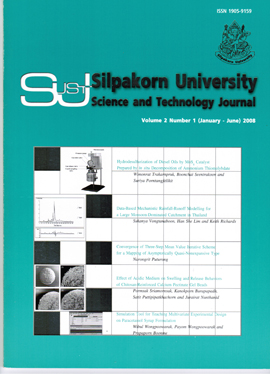Data-Based Mechanistic Rainfall-Runoff Modelling for a Large Monsoon-Dominated Catchment in Thailand
Main Article Content
Abstract
Hydrological modelling for water resource and flood management in large monsoon-dominated sub-tropicalcatchments has not been the subject of extensive research and it is not clear what the appropriate model structuresand data requirements may be. High degrees of seasonality, limited data availability, rapidly changinghydrological regimes as a result of land use change and climate variability and a lack of complete understandingof the details of the physical hydrology in these regimes and regions all contribute to this situation. This paperuses Data Based Mechanistic (DBM) modelling methods to explore the hydrology of the 3,853 km2 Mae Chaemcatchment in northern Thailand, where there is an unusually rich database of runoff and rainfall data. This is usedto examine the appropriate model structure and parameter values in DBM models and the effects of using theavailable rainfall and runoff data in a range of different ways. Rainfall data are area-weighted using Theissenpolygons, within which altitude adjustment is effected on the basis of evidence for an increase of about 0.5 mm ofrain per rainday for each 100 m increase in elevation above 1000 m, in the monsoon season only. The modelstructure suggests a second-order model and the parameter values seem to be rather stable when higher qualityrainfall data are used. Furthermore, it is possible to maintain reliable flow simulations by cascading a series of run off prediction regression models that predict a downstream flow from an upstream flow and the incrementalrainfall between gauging stations.
Downloads
Article Details
References
Hansen, D. P., Ye, W., Jakeman, A. J., Cooke, R., and Sharma, P. (1996). Analysis of the effect of rainfall and streamflow data quality and catchment dynamics on streamflow prediction using the rainfall-runoff model IHACRES. Environmental Software, 11: 193-202.
Jakeman, A. J., Littlewood, I. G., and Whitehead, P. G. (1990). Computation of the instantaneous unit hydrograph and identifiable component flows with application to two small upland catchments. Journal of Hydrology, 117: 275-300.
Kirkby, M. J. (1976). Tests of the random network model, and its application to basin hydrology. Earth Surface Processes, 1: 197-212.
Koichiro, K., Punyatrong, K., and Suzuki, M. (2001). Altitudial increase in rainfall in Mae Chaem watershed, Thailand. Journal of the Meteorological Society of Japan 1B. [OnlineURL: https://forester.uf.a.u-tokyo.ac.jp/~kuraji/MaeChaem/] accessed on April 1, 2006.
Lancaster University. (1996). Catchment rainfall-runoff modelling using Transfer Function Model with nonlinear rainfall filtering, version 1.1 for Windows.
Lim, H. S. (2006). Rainfall-runoff behaviour of catchments in the seasonally humid tropics: North Thailand. Unpublished PhD Thesis. Cambridge University, Cambridge.
Lim, H. S., Vongtanaboon, S., and Richards, K. S. (2007). Investigating the rainfall-runoff response of a small forested mountain catchment in the seasonally humid tropics using a modeling approach. IUGG XXIV General Assembly “Earth: our changing planet”. Perugia.
Okumura, K., Satomura, T., Oki, T., and Khantiyanan, W. (2003). Diurnal variation of precipitation by moving mesoscale systems: Radar observations in northern Thailand, Geophysical Research Letters, 30(20): 2073.
Post, D. A. and Jakeman, A. J. (1999). Predicting the daily streamflow of ungauged catchments in S.E. Australia by regionalising the parameters of a lumped conceptual rainfall-runoff model. Ecological Modelling, 123: 91-104.
Post, D. A., Jakeman, A. J., Littlewood, I. G.,Whitehead, P. G., and Jayasuriya, M. D. A. (1996). Modelling land-cover-induced variations in hydrologic response: Picaninny Creek, Victoria. Ecological Modelling, 86: 177-182.
Schreider, S. Yu., Whetton, P. H., Jakeman, A. J., and Pittock, A. B. (1997). Runoff modelling for snow-affected catchments in the Australian alpine region, eastern Victoria. Journal of Hydrology, 200: 1-23.
Vongtanaboon, S. (2004). Parsimonious modelling the rainfall-runoff behaviour of large catchments in Thailand. Unpublished PhD Thesis. Lancaster University, Lancaster.
Vongtanaboon, S. and Chappell, N. A. (2004). DBM rainfall-runoff modelling of large rainforest catchments in Thailand. In Forests and Water in Warm, Humid Asia (Sidle, R. C., Tani, M., Nik, A. R., and Tadese, T. A., eds.), pp.252–255. Disaster Prevention Research Institute, Uiji.
Ye, W., Jakeman, A. J., and Barnes, C. J. (1995). A parametrically efficient model for prediction of streamflow in an Australian benchmark catchment with complex storage dynamics. Environment International, 21: 539-544.
Ye, W., Jakeman, A. J., and Young, P. C. (1998). Identification of improved rainfall-runoff models for an ephemeral low-yielding Australian catchment. Environmental Modelling & Software, 13: 59-74.
Young, P. C. (1998). Data-based mechanistic modelling of environmental, ecological, economic and engineering systems. Environmental Modelling & Software, 13: 105-122.
Young, P. C. (2001). Data-based mechanistic modelling and validation of rainfall-flow processes. In Model validation: perspectives in hydrological science (Anderson, M. G. and Bates, P. D, eds.), pp. 117-161.
Young, P. C. and Beven, K. J. (1994). Data-based mechanistic modelling and the rainfall-flow non-linearity. Environmetrics, 5: 335-363.
Young, P. C. and Beven, K. (1991). Computation of the instantaneous unit hydrograph and identifiable component flows with application to two small upland catchments – Comment. Journal of Hydrology, 129: 389-396.
Young, P. C., Chotai, A., and Tych, W. (1993). Identification, Estimation and True Digital Control of Glasshouse Systems. In The computerized Greenhouse: Automatic Control Application in Plant Production (Hashimoto, Y. et al., eds.), pp. 3-50. Academic Press, New York.
Young, P. C., Jakeman, A. J., and Post, D. A. (1997). Recent advances in the data-based modelling and analysis of hydrological systems. Water Scence and Technology, 36: 99-116.


